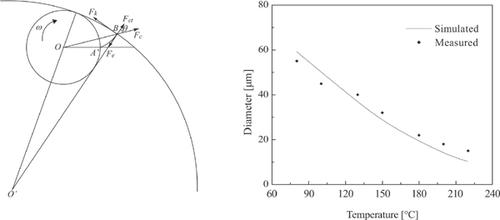Recent Patents on Nanotechnology ( IF 2.0 ) Pub Date : 2020-02-29 , DOI: 10.2174/1872210513666190801110145 Jia-Jia Liu 1 , Li-Li Wu 1 , Ting Chen 1

|
Background and Objective: Some patents have reported the centrifugal spinning method which utilizes the centrifugal force produced by a high speed rotating device to fabricate fibers from polymer melts or solutions. Recently, with the development of technologies, centrifugal spinning was employed to produce ultrafine fibers and nanofibers. In order to improve the equipment and technology of centrifugal spinning and obtain finer fibers, it is important to model the polymer drawing of the centrifugal spinning.
Methods: The polymer drawing in the centrifugal spinning is modeled and simulated. The force balance equation and heat transfer balance equation are established after analyzing the motion and heat transfer of the polymer melts. These nonlinear equations are solved based on the least square method to obtain the radius of excircle and the shape of streamline. A fourth order Runge-Kutta method is utilized to obtain the diameter and temperature of the threadline because there are initial value problems of first order ordinary differential equations. Streamlines and diameter of polymer melts at different viscoelasticities and different spinning temperatures are obtained. The simulation results are compared with the measured results to verify the polymer drawing model.
Results: The viscoelastic force in the centrifugal spinning changes constantly at a fixed rotation speed of the rotating spinneret. As the spinneret is rotating, the radius of excircle R1 increases slowly when the time passes, which means the viscoelastic force decreases slowly. The change of the viscoelastic force accelerates the increase of the radius vector. The simulation results show that the threadline diameter under the condition of changing viscoelastic forces is smaller than that under the condition of fixed visoelastic forces. The temperature of the polymer melts decreases faster under the condition of changing viscoelastic forces than that under the condition of fixed visoelastic forces. The threadline diameter decreases with the increase of the rotation speed. Higher initial polymer temperatures yield smaller fiber diameters.
Conclusion: The polymer drawing in the centrifugal spinning is modeled and simulated. The simulation results tally with the measured results confirming the effectiveness of the polymer drawing model. The simulation results show that the change of the viscoelastic force is favorable to the polymer drawing and both larger rotation speeds and higher initial polymer temperatures can produce finer fibers, which lays a good foundation for the computer-assisted design of the centrifugal spinning.
中文翻译:

离心纺丝的聚合物拉伸模型研究。
背景和目的:一些专利已经报道了离心纺丝方法,该方法利用高速旋转装置产生的离心力从聚合物熔体或溶液中制备纤维。近年来,随着技术的发展,离心纺丝被用于生产超细纤维和纳米纤维。为了改善离心纺丝的设备和技术并获得更细的纤维,对离心纺丝的聚合物拉伸进行建模很重要。
方法:对离心纺丝中的聚合物拉伸进行建模和模拟。通过分析聚合物熔体的运动和传热,建立了力平衡方程和传热平衡方程。基于最小二乘法求解这些非线性方程,得到圆弧半径和流线形状。由于存在一阶常微分方程的初值问题,因此采用四阶Runge-Kutta方法获得螺纹的直径和温度。获得了在不同的粘弹性和不同的纺丝温度下聚合物熔体的流线和直径。将模拟结果与测量结果进行比较,以验证聚合物绘制模型。
结果:离心纺丝中的粘弹性力在旋转喷丝头的固定转速下不断变化。随着喷丝头的旋转,随着时间的流逝,外圆R1的半径会缓慢增加,这意味着粘弹性力会缓慢减小。粘弹性力的变化加速了半径矢量的增加。仿真结果表明,在改变粘弹性力的条件下,线径要比在固定粘弹性力的条件下的线径小。在改变粘弹性力的条件下,聚合物熔体的温度下降比在固定粘弹性力的条件下下降得更快。螺纹直径随着转速的增加而减小。较高的初始聚合物温度产生较小的纤维直径。
结论:对离心纺丝中的聚合物拉伸进行了建模和模拟。仿真结果与测量结果相符,证实了聚合物绘制模型的有效性。仿真结果表明,粘弹性力的变化有利于聚合物的拉伸,较大的转速和较高的初始聚合物温度均可产生较细的纤维,这为离心纺丝的计算机辅助设计奠定了良好的基础。











































 京公网安备 11010802027423号
京公网安备 11010802027423号